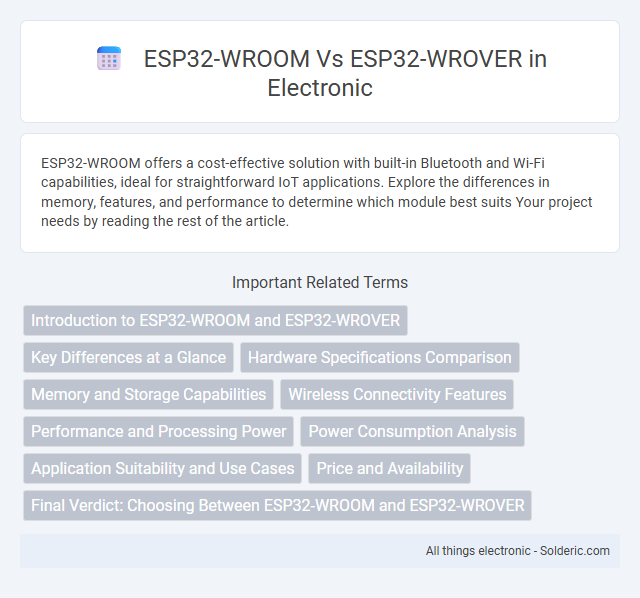ESP32-WROOM offers a cost-effective solution with built-in Bluetooth and Wi-Fi capabilities, ideal for straightforward IoT applications. Explore the differences in memory, features, and performance to determine which module best suits Your project needs by reading the rest of the article.
Comparison Table
| Feature | ESP32-WROOM | ESP32-WROVER |
|---|---|---|
| Microcontroller | ESP32 Dual-core Tensilica LX6 | ESP32 Dual-core Tensilica LX6 |
| Flash Memory | 4MB | 4MB or 8MB |
| PSRAM | None | 4MB external PSRAM |
| Wi-Fi | 802.11 b/g/n (2.4 GHz) | 802.11 b/g/n (2.4 GHz) |
| Bluetooth | Bluetooth v4.2 BR/EDR and BLE | Bluetooth v4.2 BR/EDR and BLE |
| Dimensions | 18 x 25.5 mm | 18 x 33 mm |
| Interfaces | SPI, I2C, UART, ADC, DAC, PWM | SPI, I2C, UART, ADC, DAC, PWM |
| Application | General IoT projects, low memory needs | Advanced IoT, AI, video streaming requiring extra RAM |
Introduction to ESP32-WROOM and ESP32-WROVER
ESP32-WROOM and ESP32-WROVER are popular Wi-Fi and Bluetooth modules designed by Espressif, featuring the powerful ESP32 series chip for IoT applications. ESP32-WROOM is optimized for general wireless connectivity, offering sufficient memory and processing power for most embedded tasks, while ESP32-WROVER integrates additional PSRAM, enhancing capabilities for complex applications like image processing and audio encoding. Understanding these core distinctions helps you select the appropriate module for your specific project requirements.
Key Differences at a Glance
ESP32-WROOM and ESP32-WROVER differ primarily in onboard memory, with WROVER including additional PSRAM up to 8MB compared to WROOM's absence of PSRAM, enhancing performance for complex applications. Both modules use the same dual-core processor and support Wi-Fi/Bluetooth connectivity, but WROVER's expanded memory better suits multimedia, AI, and IoT projects requiring extensive data processing. Your choice depends on whether extra memory for buffer-intensive tasks or cost-efficiency with basic functionality is prioritized.
Hardware Specifications Comparison
The ESP32-WROOM features a dual-core processor with up to 240 MHz clock speed, 4 MB of flash memory, and 520 KB SRAM, suitable for standard IoT applications. The ESP32-WROVER enhances performance by including a 4 MB PSRAM alongside the 4 MB flash, providing improved memory capacity for more demanding tasks like audio processing and caching. Both modules support Wi-Fi and Bluetooth connectivity, but the WROVER's increased RAM makes it ideal for complex applications requiring higher data buffering and processing power.
Memory and Storage Capabilities
ESP32-WROVER modules typically feature larger PSRAM, up to 8MB compared to the ESP32-WROOM's standard 4MB, enhancing performance for memory-intensive applications. Storage for both modules generally includes 4MB to 16MB SPI flash, but the WROVER's expanded PSRAM supports advanced tasks such as video processing and complex IoT analytics. Your choice between ESP32-WROOM and ESP32-WROVER should consider these distinctions, especially if your project demands ample memory and efficient storage handling.
Wireless Connectivity Features
ESP32-WROOM and ESP32-WROVER modules both support dual-mode Bluetooth 4.2 and 2.4 GHz Wi-Fi 802.11 b/g/n standards, ensuring robust wireless connectivity. The ESP32-WROVER includes additional PSRAM for enhanced memory, which benefits complex wireless applications requiring larger data buffers. Your choice depends on whether you need extra memory for advanced wireless functions or prefer a more compact solution.
Performance and Processing Power
The ESP32-WROOM features a dual-core LX6 processor clocked up to 240 MHz, suitable for standard IoT applications requiring efficient performance and low power consumption. In contrast, the ESP32-WROVER includes the same dual-core LX6 processor but is equipped with additional PSRAM (typically 4MB), enhancing memory capacity for more demanding tasks such as image processing, complex processing, and real-time data handling. The added PSRAM in the ESP32-WROVER enables smoother multi-tasking and higher processing throughput, making it ideal for high-performance embedded systems.
Power Consumption Analysis
The ESP32-WROOM module typically features lower power consumption due to the absence of onboard PSRAM compared to the ESP32-WROVER, which includes additional PSRAM increasing overall energy usage. In deep sleep mode, both modules can achieve power consumption as low as 5 uA, but the WROVER's extra memory and peripherals can raise active mode consumption from approximately 80 mA (WROOM) to around 90 mA under similar conditions. When designing battery-powered applications, selecting ESP32-WROOM is preferable for energy efficiency, while ESP32-WROVER suits projects requiring enhanced memory despite higher power demands.
Application Suitability and Use Cases
ESP32-WROOM is ideal for cost-effective applications requiring reliable Wi-Fi and Bluetooth connectivity with moderate memory demands, such as IoT sensors and smart home devices. ESP32-WROVER features integrated PSRAM, making it suitable for memory-intensive tasks like real-time audio processing, video streaming, and advanced AI edge computing. Both modules support versatile embedded applications, but WROVER's expanded RAM and enhanced performance cater to complex, high-data workloads.
Price and Availability
ESP32-WROOM modules typically offer a lower price point and broader availability due to their simpler design and widespread use in basic IoT applications. ESP32-WROVER modules, featuring additional PSRAM and enhanced capabilities, come at a higher cost and may have more limited stock compared to WROOM variants. When choosing between the two, consider Your budget constraints and availability timelines for your project requirements.
Final Verdict: Choosing Between ESP32-WROOM and ESP32-WROVER
ESP32-WROOM modules are ideal for standard IoT applications requiring robust Wi-Fi and Bluetooth connectivity with moderate memory needs. ESP32-WROVER variants offer enhanced performance through additional PSRAM, making them suitable for more demanding tasks such as image processing and complex sensor data handling. Selecting between ESP32-WROOM and ESP32-WROVER depends on the specific project requirements for memory capacity, processing power, and peripheral support.
ESP32-WROOM vs ESP32-WROVER Infographic

 solderic.com
solderic.com